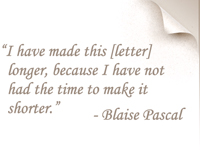A friend of mine who works at a well-known Silicon Valley company recently suggested that I write about how to use email. Though he didn’t tell me the particular incident that occasioned his remark, anyone who spends a lot of time responding to email probably has a list of rules that they’d wish the rest of the world would abide by.
Here are mine, at least for business contexts:
- Answer in a timely manner, and if you need a timely response, say so at the top of the email.
- Be concise.
- Be personable. Unless you’re engaged in a quick back-and-forth exchange, greet someone by name and sign off warmly or sincerely.
- Respond to all questions and issues.
- Use meaningful subject lines, and include the last message in a thread as a a reference.
- Don’t use email in situations of high value or conflict. Use the phone or a face-to-face meeting instead.
- Do not discuss confidential information (emails have a way of moving from “private” to “public” with the push of a button).
- Do not forward emails from others without permission (and don’t forward chain emails at all, please!).
- Use proper spelling, grammar, and punctuation, and use acronyms or abbreviations sparingly, making sure your reader knows them.
- Review what you’ve written, before hitting the “send” button.
Of course, it’s one thing to know the rules and another to apply them. I’ve violated all of these at one time or another (“be concise” is probably my biggest challenge). It’s funny how little things matter, though.
I once had a secretary who was a model of brevity, and couldn’t add a “warm fuzzy” to save her soul. After hearing that she had offended several teachers with her emails (I was a university program administrator), I constructed a template for her to use, which required her to greet individuals by name, start with a “thank you” at the beginning for their question or concern, and sign off with a “sincerely,” at the conclusion. I also suggested she use the word “please” whenever she made a request. These additions might not seem like much, but were enough to soften the tone of simple emails such as “Turn in your grades,” which struck the recipients as rude and commanding.
Probably the most challenging rule is to switch to the phone in situations of high value or conflict. Personally, I much prefer email to using the phone, especially where emotions are at play (mine or others). After all, who wants to talk to someone that you know is angry with you, or who you are hoping will hire you for a big project, but they didn’t get back to you when they said they would? Email is just so much easier to hide behind.
But email, especially when it is concise, is not especially good at conveying tone. Linguists tell us that over half the information in a conversation is conveyed by voice or body language, so email–which lacks both–is a poor instrument for handling complex situations. And because email lacks so much in terms of these other communication channels, it’s important to pay attention to what we do write.


{ 1 comment… read it below or add one }
I would add a corollary to Number 10: check, and then double-check, to see that you are sending the email to the person or persons you intend!
More than once I have seen people in the middle of intense negotiations mis-address an email that set out the writers’ opinions about where a negotiation was going to end up, e.g., where the other side’s position was strong, where their own side’s position was weak, etc.
So these folks thought they were sending this highly confidential email to people on the same side of the negotiation, only to see, after they hit “send,” that they had in fact sent the email to to the people on the other side of the negotiation — the very worst people to see it.
That is, to say the least, very embarrassing.